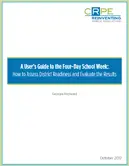The move to a four-day school week started as a cost-saving measure for small, rural school districts. As the idea has spread to more districts across the country, the motivation and format have shifted. While cost savings from the shortened schedule have been found to be minimal, there can be other benefits, like time for additional teacher training, focused intervention for students, or extracurricular activities.
But moving to a four-day schedule is a complex endeavor, especially if districts don’t have clear and realistic goals for what they are trying to achieve and structures in place to assess results.
This guide is intended to help district and community leaders understand the benefits and drawbacks of the four-day school week. It provides an overview of common goals, outcomes, and unintended consequences. A set of questions and tools help districts assess their readiness to make the switch and evaluate the results. Recommendations for successful implementation draw from lessons learned and practices that have worked for districts that have adopted the shorter school week.





